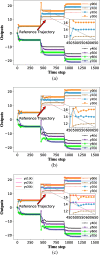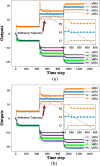Data-based bipartite formation control for multi-agent systems with communication constraints
- PMID: 38361488
- PMCID: PMC10874164
- DOI: 10.1177/00368504241227620
Data-based bipartite formation control for multi-agent systems with communication constraints
Abstract
This article investigates data-driven distributed bipartite formation issues for discrete-time multi-agent systems with communication constraints. We propose a quantized data-driven distributed bipartite formation control approach based on the plant's quantized and saturated information. Moreover, compared with existing results, we consider both the fixed and switching topologies of multi-agent systems with the cooperative-competitive interactions. We establish a time-varying linear data model for each agent by utilizing the dynamic linearization method. Then, using the incomplete input and output data of each agent and its neighbors, we construct the proposed quantized data-driven distributed bipartite formation control scheme without employing any dynamics information of multi-agent systems. We strictly prove the convergence of the proposed algorithm, where the proposed approach can ensure that the bipartite formation tracking errors converge to the origin, even though the communication topology of multi-agent systems is time-varying switching. Finally, simulation and hardware tests demonstrate the effectiveness of the proposed scheme.
Keywords: Data-driven control; bipartite formation; data quantization; multi-agent systems; sensor saturation.
Conflict of interest statement
Declaration of conflicting interestsThe author(s) declared no potential conflicts of interest for the research, authorship, and/or publication of this article.
Figures









Similar articles
-
Distributed Model-Free Bipartite Consensus Tracking for Unknown Heterogeneous Multi-Agent Systems with Switching Topology.Sensors (Basel). 2020 Jul 27;20(15):4164. doi: 10.3390/s20154164. Sensors (Basel). 2020. PMID: 32726953 Free PMC article.
-
Event-Triggered Distributed Data-Driven Iterative Learning Bipartite Formation Control for Unknown Nonlinear Multiagent Systems.IEEE Trans Neural Netw Learn Syst. 2022 Jun 8;PP. doi: 10.1109/TNNLS.2022.3174885. Online ahead of print. IEEE Trans Neural Netw Learn Syst. 2022. PMID: 35675240
-
Adaptive Bipartite Event-Triggered Time-Varying Output Formation Tracking of Heterogeneous Linear Multi-Agent Systems Under Signed Directed Graph.IEEE Trans Neural Netw Learn Syst. 2023 Oct;34(10):7049-7058. doi: 10.1109/TNNLS.2021.3137393. Epub 2023 Oct 5. IEEE Trans Neural Netw Learn Syst. 2023. PMID: 35044922
-
Command filter based adaptive fuzzy bipartite output consensus tracking of nonlinear coopetition multi-agent systems with input saturation.ISA Trans. 2018 Sep;80:187-194. doi: 10.1016/j.isatra.2018.07.039. Epub 2018 Aug 10. ISA Trans. 2018. PMID: 30104036
-
Model-Free Adaptive Iterative Learning Bipartite Containment Control for Multi-Agent Systems.Sensors (Basel). 2022 Sep 20;22(19):7115. doi: 10.3390/s22197115. Sensors (Basel). 2022. PMID: 36236210 Free PMC article.
References
-
- Liu H, Tian Y, Lewis FL. Robust trajectory tracking in satellite time-varying formation flying. IEEE T Cybern 2020; 51: 5752–5760. - PubMed
-
- Wang Z, Zou Y, Liu Y, et al.. Distributed control algorithm for leader-follower formation tracking of multiple quadrotors: Theory and experiment. IEEE-ASME Trans Mechatron 2021; 26: 1095–1105.
-
- Peng H, Wang J, Wang S, et al.. Coordinated motion control for a wheel-leg robot with speed consensus strategy. IEEE-ASME Trans Mechatron 2020; 25: 1366–1376.
-
- Lv M, Ahn CK, Zhang B, et al.. Fixed-time anti-saturation cooperative control for networked fixed-wing unmanned aerial vehicles considering actuator failures. IEEE Trans Aerosp Electron Syst 2023; 59(6): 8812–8825.
LinkOut - more resources
Full Text Sources

